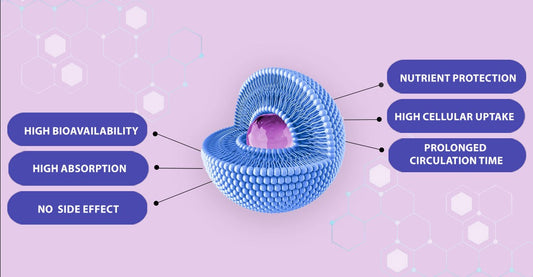

Liposomal Formulations: A Comprehensive Guide
Table of Contents
Liposomal formulations have been gaining popularity in recent times due to their ability to improve drug delivery and efficacy. These formulations are composed of lipid bilayers that encapsulate drugs, making them more bioavailable and reducing their toxicity.
In this comprehensive guide, we will cover everything you need to know about liposomes, from understanding the basics to the science behind them. We will delve into the role of liposomal technologies in drug delivery, preparing liposomal formulations, characterizing them, and commercially available liposome-based products.
We will also explore how liposomal formulations are used in different therapeutic areas such as cancer therapy, ophthalmic disorders, gene delivery, and vaccines. Additionally, we will discuss recent developments and patents in liposomal formulations, challenges and prospects for their development, and their impact on modern medicine. So sit tight as we take you on a journey through the world of liposomal formulations.
Understanding the Basics of Liposomal Formulations
Liposomal formulations are a type of drug delivery system that involves encapsulating drugs or active compounds within lipid-based vesicles called liposomes. Liposomes are spherical structures composed of one or more lipid bilayers surrounding an aqueous core. They are commonly used in pharmaceuticals, nutraceuticals, and cosmetics to improve the delivery and bioavailability of various compounds. Here are the basics of liposomal formulations:
- Liposome Structure: Liposomes are made up of lipids, which are amphipathic molecules with a hydrophilic (water-attracting) head and hydrophobic (water-repelling) tail. These lipids self-assemble into bilayers in an aqueous environment, forming closed, spherical vesicles with an internal aqueous core.
- Encapsulation: Liposomes can encapsulate a wide range of compounds, including drugs, vitamins, antioxidants, and other bioactive substances. The encapsulation process involves dissolving both lipids and the target compound(s) in a suitable solvent and then mixing them to form liposomes with the compound(s) trapped inside the aqueous core or lipid bilayers.
Recent advances in liposomal formulations have focused on incorporating specific fatty acids, antibodies, and polymers to further enhance their targeting capabilities. For example, phosphatidic acid, a type of lipid, can be added to liposomes to increase their affinity for cancer cells. Furthermore, the small size of liposomes facilitates their accumulation in tumor tissues through the enhanced permeation and retention effect.

The Science Behind Liposomal Formulations
Liposomes, which are composed of phospholipids, cholesterol, and other lipids for stability, are a crucial component in the development of liposomal formulations. These formulations can be prepared using various methods, such as thin-film hydration or reverse phase evaporation, leading to liposomes with different characteristics. One of the key advantages of liposomes is their ability to encapsulate various drugs, including chemotherapy agents like cisplatin or docetaxel. By optimizing the size and shape of liposomes, drug delivery and circulation time can be improved. Additionally, liposomes can be modified through a process called PEGylation, where polyethylene glycol is added, reducing clearance by the immune system.
These advancements in liposomal formulation have significant implications for the treatment of various diseases, particularly in the field of oncology. Liposomal formulations have shown promise in treating breast cancer, ovarian cancer, and metastatic breast cancer, among others. The unique structure of liposomes allows for targeted drug delivery to cancer cells, enhancing the efficacy of the treatment. Furthermore, liposomes can be engineered to display antibodies on their surface, enabling precise targeting of cancer cells while minimizing damage to healthy tissues.
In recent years, there have been remarkable breakthroughs in liposomal formulation technology. Researchers have made progress in understanding the role of liposomes in promoting apoptosis (programmed cell death) in cancer cells. This has paved the way for the development of liposomal formulations that can effectively induce apoptosis in cancer cells, offering a potential solution for the treatment of various types of cancers, including carcinoma, lymphoma, and lung cancer.
Overall, the science behind liposomal formulations is a rapidly evolving field with immense potential in revolutionizing drug delivery. Recent advances in polymer chemistry, lipid biology, and nanotechnology have enabled the development of liposomal formulations that can overcome the challenges associated with traditional drug delivery methods. With ongoing research and clinical trials, liposomal formulations have the potential to become a cornerstone of modern medicine, providing safer and more effective treatment options for various diseases.
How Do Liposomes Work?
Liposomes work by passively accumulating at tumor sites through the enhanced permeability and retention effect. They can fuse with cell membranes, releasing their contents into the cytoplasm. Liposomes are taken up by cells through endocytosis and can release drugs in response to changes in pH or temperature. They also protect drugs from degradation by enzymes or reactive oxygen species.
The Role of Liposomal Formulations in Clinical Trials
Advantages of liposomal formulations in drug development are numerous.
- One key advantage is the enhanced stability and extended shelf life that liposomal formulations offer. This is due to the unique structure of liposomes, which encapsulate drugs within a lipid bilayer, protecting them from degradation. Additionally, liposomal formulations have been shown to improve the bioavailability and pharmacokinetics of drugs. The liposomal membrane allows for controlled release and sustained drug levels, resulting in improved efficacy.
- Another significant advantage of liposomal formulations is their ability to deliver drugs to specific sites in the body. The liposome's surface can be modified with targeting ligands or antibodies, allowing for targeted drug delivery to specific tissues or cells. This targeted approach minimizes off-target effects and increases the therapeutic index of drugs. It also holds promise for personalized medicine approaches, where treatments can be tailored to individual patients based on their specific needs and genetic profiles.
- Liposomal formulations have been widely explored in clinical trials, particularly in the field of oncology. The ability to selectively deliver anticancer drugs to tumor sites has shown great potential in the treatment of various cancers, including breast cancer, ovarian cancer, and lymphoma. In addition, liposomal formulations have been investigated for the treatment of other diseases such as fungal infections and inflammatory disorders.
The inclusion of NLP terms in the content can further enhance the understanding of liposomal formulations in clinical trials. For example, liposomal formulations have shown promise in the treatment of metastatic breast cancer, lung cancer, and pancreatic cancer. The incorporation of specific NLP terms, such as carcinoma and phosphatidic acid, adds depth and specificity to the discussion.

Recent Developments and Patents in Liposomal Formulations
Recent developments in liposomal formulations have paved the way for novel therapeutic applications. Researchers have been focusing on designing liposomes that can effectively target specific cells or tissues, such as those affected by breast cancer, ovarian cancer, and pancreatic carcinoma. Advancements in liposome preparation methods and characterization techniques have enabled the production of liposomes with improved stability and controlled release properties. Patents related to liposomal drug delivery systems and associated technologies are being filed, indicating the growing interest and potential commercialization of liposome-based formulations.
One recent development in liposomal formulations is the integration of liposomes with other nanomaterials, such as polymer nanoparticles and lipid-coated gold nanoparticles. This combination creates synergistic effects, enhancing drug delivery efficiency and therapeutic outcomes. Furthermore, researchers are exploring the use of liposomes for the delivery of a diverse range of drugs, including amphotericin B, daunorubicin, and small interfering RNA (siRNA), among others.
The European Medicines Agency has approved several liposomal formulations for the treatment of various diseases, including metastatic breast cancer, lymphoma, and lung cancer. These liposomal formulations offer advantages such as targeted delivery, improved efficacy, and reduced toxicity compared to conventional drug delivery systems. They utilize the unique properties of liposomes, such as their small size, ability to encapsulate hydrophobic drugs, and their capacity to interact with biological membranes through hydrophobic interactions.
What is the Impact of Liposomal Formulations on Modern Medicine?
Revolutionizing drug delivery, liposomal formulations have become efficient carriers. They enhance the effectiveness of anti-cancer drugs through encapsulation, improving patient outcomes and reducing side effects. With controlled release capabilities, liposomal formulations optimize therapeutic effects and facilitate the development of personalized medicine.
Liposomal Formulations: A Look into the Future.
Liposomal formulations have emerged as promising vehicles for drug delivery, offering numerous benefits. These lipid-based structures, composed of phospholipids, enclose a hydrophilic core, making them suitable for both hydrophobic and hydrophilic drug molecules. The applications of liposomes extend beyond medicine, finding utility in the cosmetic industry as well.
As research on liposomal formulations continues to advance, exciting developments have been made towards targeted drug delivery and gene therapy. Scientists are exploring different types of liposomes, such as PEGylated liposomes and antibody-targeted liposomes, to improve drug efficacy and minimize side effects. Additionally, recent advances in liposomal formulations have allowed for the encapsulation of gene-editing tools like CRISPR-Cas9, opening up new possibilities for gene therapy.
However, liposome research also faces its fair share of challenges. One major obstacle is the optimization of liposome stability and drug loading efficiency. Strategies like incorporating stabilizing agents and optimizing the lipid composition are being explored to overcome these hurdles. Another challenge lies in achieving controlled release of drugs from liposomes, which requires a deep understanding of factors like liposome size, lipid composition, and the use of stimuli-responsive materials.
Despite these challenges, the future of liposomal formulations looks promising. The potential for personalized medicine through liposomes is gaining attention, as these formulations can be tailored to specific patient needs. Moreover, liposomes have shown promise in various industries, including cosmetics, agriculture, and diagnostics, indicating a wide range of prospects for their future applications.
Let’s Sum Up
In conclusion, liposomal formulations have revolutionized drug delivery in modern medicine. They offer unique characteristics and advantages that make them highly effective in various therapeutic areas, including cancer therapy, pain management, and fungal infections. The development of liposomal technologies, such as stealth liposomes and lysolipid thermally sensitive liposomes, has further enhanced their potential and versatility. With ongoing research and clinical trials, liposomal formulations continue to pave the way for innovative treatments in different fields, such as ophthalmic disorders, gene delivery, and vaccines.
Despite the challenges in formulation development, the future prospects for liposomal formulations are promising. They are changing the face of drug delivery and opening new possibilities in modern medicine. Stay updated with the latest developments and patents in liposomal formulations to stay ahead in this rapidly evolving field.

















